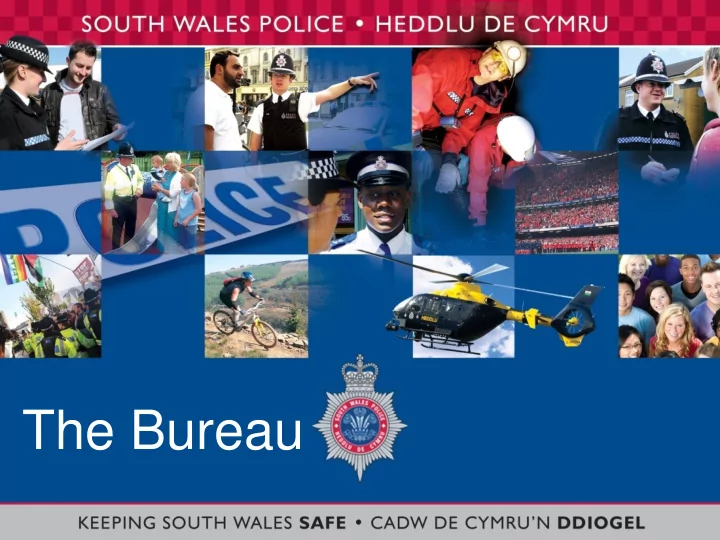

NOT PROTECTIVELY MARKED 1 The Bureau 28/09/16 1 NOT PROTECTIVELY MARKED
NOT PROTECTIVELY MARKED The Bureau The Western Bay Bureau is an innovative youth crime prevention initiative which is designed to divert young people out of the criminal justice system. The Bureau process aims to tackle underlying causes which promote youth crime and seeks to promote pro- social behaviour. NOT PROTECTIVELY MARKED
NOT PROTECTIVELY MARKED Bureau Process • Police computer checked daily • Allocated to worker to complete an assessment • Victim liaison officer informed • Report written • Discussion at Bureau and decision • Clinic held and disposal given • Programme completed where appropriate NOT PROTECTIVELY MARKED
NOT PROTECTIVELY MARKED Participants The Bureau is chaired by a Police Sergeant A Lay Person - Volunteer acts as a community representative Representative from the Youth Offending Service The Bureau Co-Ordinator (Police Constable ) who presents the information NOT PROTECTIVELY MARKED
NOT PROTECTIVELY MARKED Available Outcomes • Youth Restorative Disposal • Youth Caution • Youth Conditional Caution • Prosecution NOT PROTECTIVELY MARKED
NOT PROTECTIVELY MARKED Restorative processes • The focus is to make good the harm caused • Involves the participation of the victim and the young person • Either or both can have supporters present • Involvement is voluntary by all parties • Can involve direct or indirect reparation • Can be an alternative to or an addition to police involvement NOT PROTECTIVELY MARKED
NOT PROTECTIVELY MARKED Examples of Restorative Processes • Informal restorative meeting with the victim and offender to identify the impact of the offence and work together to come to a resolution • Formal restorative justice conference which involves the young person, their parents/guardians, the victim and the victim’s family or supporters and can wider community if the offence is a community issue • shuttle mediation • use of a victim impact awareness statement to inform victim work • production of a letter of explanation or apology. NOT PROTECTIVELY MARKED
NOT PROTECTIVELY MARKED Youth Caution • The Youth Caution is a formal out-of-court disposal • The young person must admit the offence • Participation in the interventions attached to a Youth Caution is voluntary and there is no separate penalty for failing to comply with them • Failing to comply however would be a consideration in the choice of any future disposal options. NOT PROTECTIVELY MARKED
NOT PROTECTIVELY MARKED Youth Conditional Caution • A formal out-of-court disposal • Assessment and intervention compulsory • The YOT must assess the young person and advise on appropriate conditions • The young person must also agree to accept the Youth Conditional Caution and the conditions attached • Conditions can be reparative, rehabilitative or punitive in nature • The YOT is responsible for monitoring compliance with conditions and advising on non-compliance NOT PROTECTIVELY MARKED
NOT PROTECTIVELY MARKED Youth Conditional Caution continued • The victim’s consent must be obtained where direct reparation or restorative justice processes are being considered • Restorative justice processes and initiatives may be used to help inform the decision as to the conditions to be attached to a Youth Conditional Caution • Failure to comply with the conditions can result in prosecution for the original offence. NOT PROTECTIVELY MARKED
NOT PROTECTIVELY MARKED Charge Charging an offender means that the case will be put forward for prosecution in court. NOT PROTECTIVELY MARKED
NOT PROTECTIVELY MARKED No further action If a young person is arrested and the police do not pursue the case, this is known as taking ‘no further action’. It is an acknowledgement that no action is appropriate or warranted in a particular case. This could arise if there is no substantive offence or if the young person makes no admission and there is insufficient independent evidence to charge them. NOT PROTECTIVELY MARKED
NOT PROTECTIVELY MARKED Restorative Approaches / Community Resolution Are the nationally recognised terms for the resolution of a minor offence or anti-social behaviour incident through informal agreement between the parties involved, as opposed to progression through the traditional criminal justice process. Community resolution is a tool to enable the police to make decisions about how to deal more proportionately with low-level crime and is primarily aimed at first-time offenders where there has been an admission of guilt, and where the victim’s views have been taken into account. Restorative Approaches / Community resolution enables police officers to use their professional judgement to assess an offence, taking into account the wishes of the victim and the offender’s history in order to reach an outcome which best meets the needs of the victim and of the public. NOT PROTECTIVELY MARKED
Recommend
More recommend